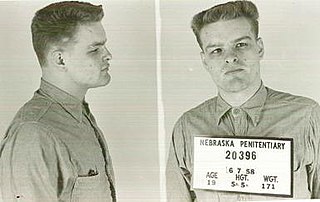Related Research Articles

A serial killer is a person who murders two or more people, with the killings taking place over a significant period of time between them. The serial killers' psychological gratification is the motivation for the killings, and many serial murders involve sexual contact with the victims at different points during the murder process. The Federal Bureau of Investigation (FBI) states that the motives of serial killers can include anger, thrill-seeking, financial gain, and attention seeking, and killings may be executed as such. The victims tend to have things in common such as, demographic profile, appearance, gender or race. The FBI will focus on particular patterns that the serial killers follow throughout their murders. They will then use on the patterns they find for key clues into finding the killer along with their motives. Although a serial killer is a distinct classification that differs from that of a mass murderer, spree killer, or contract killer, there are overlaps between them.

Mass murder is the violent crime of killing a number of people, typically simultaneously or over a relatively short period of time and in proximity. A mass murder typically occurs in a single location where one or more persons kill several others.

Andrew Phillip Cunanan was an American spree killer who murdered five people over three months from April 27 to July 15, 1997. His victims include Italian fashion designer Gianni Versace and Chicago real estate developer Lee Miglin. Cunanan died by suicide on July 23, 1997, eight days after murdering Versace.

Charles Raymond Starkweather was an American spree killer who murdered eleven people in Nebraska and Wyoming between November 1957 and January 1958, when he was nineteen years old. He killed ten of his victims between January 21 and January 29, 1958, the date of his arrest. During his spree in 1958, Starkweather was accompanied by his fourteen-year-old girlfriend, Caril Ann Fugate.
A thrill killing is premeditated or random murder that is motivated by the sheer excitement of the act. While there have been attempts to categorize multiple murders, such as identifying "thrill killing" as a type of "hedonistic mass killing", actual details of events frequently overlap category definitions making attempts at such distinctions problematic.

Caril Ann Fugate is the youngest female in United States history to have been tried and convicted of first-degree murder. She was the adolescent girlfriend of spree killer Charles Starkweather, being just 14 years old when his murders took place in 1958. She was convicted as his accomplice and sentenced to life imprisonment. In 1976, she was paroled after serving 18 years.
The National Center for the Analysis of Violent Crime (NCAVC) is a specialist FBI department. The NCAVC's role is to coordinate investigative and operational support functions, criminological research, and training in order to provide assistance to federal, state, local, and foreign law enforcement agencies investigating unusual or repetitive violent crimes.

Robert Kenneth Ressler was an American FBI agent and author. He played a significant role in the psychological profiling of violent offenders in the 1970s and is often credited with coining the term "serial killer", though the term is a direct translation of the German term Serienmörder coined in 1930 by Berlin investigator Ernst Gennat. After retiring from the FBI, he authored a number of books on serial murders, and often gave lectures on criminology.

Offender profiling, also known as criminal profiling, is an investigative strategy used by law enforcement agencies to identify likely suspects and has been used by investigators to link cases that may have been committed by the same perpetrator. The ancestor of modern profiling, R. Ressler of the FBI, considered profiling as a process of identifying all the psychological characteristics of an individual, forming a general description of the personality, based on the analysis of the crimes committed by him or her.

John Edward Douglas is an American retired special agent and unit chief in the United States Federal Bureau of Investigation (FBI).
Jack Levin specializes in research on murder, prejudice and hate, sociology of aging and sociology of conflict at Northeastern University in Boston, Massachusetts. He has interviewed and corresponded with brutal killers, such as the Hillside Strangler and Charles Manson, and other violent criminals: serial killers and rapists, mass murderers, and vicious hatemongers. He is also asked by news and television reports to comment on important occurrences of homicide or hate. Along with interviews, writing material, teaching classes, and research Levin has also given talks about violence or hate to groups including the White House Conference on Hate Crimes, Department of Justice, the Department of Education, OSCE’s Officer for Democratic Institutions and Human Rights and the International Association of Chiefs of Police. Jack Levin has authored and co-authored over 30 books and has written and published over 200 articles.
A copycat crime is a criminal act that is modeled after or inspired by a previous crime. It notably occurs after exposure to media content depicting said crimes, and/or a live criminal model.

The Behavioral Science Unit (BSU) is the original name of a unit within the Federal Bureau of Investigation's (FBI) Training Division at Quantico, Virginia, formed in response to the rise of sexual assault and homicide in the 1970s. The unit was usurped by the Critical Incident Response Group (CIRG) and renamed the Behavioral Research and Instruction Unit (BRIU) and currently is called the Behavioral Analysis Unit (5) (BAU-5) within the National Center for Analysis of Violent Crime (NCAVC). The BAU-5 currently works on developing research and then using the evidence-based results to provide training and improve consultation in the behavioral sciences—understanding who criminals are, how they think, why they do what they do—for the FBI and law enforcement communities.
The Macdonald triad is a set of three factors, the presence of any two of which are considered to be predictive of, or associated with, violent tendencies, particularly with relation to serial offenses. The triad was first proposed by psychiatrist J. M. Macdonald in "The Threat to Kill", a 1963 article in the American Journal of Psychiatry. Small-scale studies conducted by psychiatrists Daniel Hellman and Nathan Blackman, and then FBI agents John E. Douglas and Robert K. Ressler along with Ann Burgess, claimed substantial evidence for the association of these childhood patterns with later predatory behavior. Although it remains an influential and widely taught hypothesis, subsequent research has generally not validated this line of thinking.
Infamous Murders was a documentary television series shown on The History Channel in the U.S. and the U.K. The U.S. edition was narrated by Don Peoples. In the U.K. edition the narrator is uncredited.
Crime rates in the state of Washington grew rapidly to large levels from 1960 to 1980, however slowed in growth from 1980 onward. Although the cause of this drop in crime growth from the 1980s cannot be directly determined, it was believed to have been a result from several law enforcement initiatives & policies implemented throughout the state of Washington and across the United States, such as abortion access.

James Alan Fox is the Lipman Family Professor of Criminology, Law, and Public Policy and former dean at Northeastern University in Boston, Massachusetts, in the United States. Fox holds a bachelor's degree in sociology (1972), a master's degree in criminology (1974), a master's degree in statistics (1975), and a Ph.D. in sociology (1976), all from the University of Pennsylvania.
Born to Kill? is a British true crime television series, made by Twofour Productions. Each episode is an in-depth look at the childhood, and formative years of serial killers in an attempt to find out whether the individuals were born killers, or created by the environments they found themselves in.
Lists of murderers include lists of rampage killers who kill two or more victims in a short time, including mass murderers and spree killers, and lists of serial killers, who murder three or more people over more than a month, with a significant period of time between the murders.
References
- 1 2 Morton, Robert J.; Hilts, Mark A., eds. (2008). "Serial Murder: Multi-Disciplinary Perspectives for Investigators". National Center for the Analysis of Violent Crime, Federal Bureau of Investigation. p. 9. Retrieved July 20, 2023.
- ↑ Zawitz, Marianne W., ed. (1988). Report to the Nation on Crime and Justice (PDF) (2nd ed.). Bureau of Justice Statistics. p. 4. Retrieved July 20, 2023.
- ↑ Charalambous, Nick; Dillman, Meryl (December 17, 2006). "No evidence of spree killer yet, police say". The Anderson Independent-Mail . Anderson, South Carolina. Archived from the original on December 30, 2008. Retrieved July 8, 2008.
- ↑ Levinson, David (ed.): Encyclopedia of Crime and Punishment, Vol. 4 ; Berkshire Publishing Group, 2002. p. 1565
- ↑ Levinson, p. 1038.
- ↑ Douglas, John E. & Olshaker, Mark: The Anatomy of Motive ; Simon and Schuster, 1999.
- ↑ Levin, Jack & Fox, James Alan: Mass Murder: America's Growing Menace, Berkley Books, 1991.
- ↑ Levin, Jack: Serial Killers and Sadistic Murderers, Prometheus Books, 2008. p. 49.
- ↑ Fuller, John R. & Hickey, Eric W.: Controversial Issues in Criminology; Allyn and Bacon, 1999. pp. 36.
- ↑ Holmes, R. M, & Holmes, S. T.: Serial Murder; SAGE Publications, 2010. pp. 35.
- ↑ Holmes, R. M, & Holmes, S. T.: Serial Murder; SAGE Publications, 2010. pp. 36.
- ↑ Holmes, R. M, & Holmes, S. T.: Serial Murder; SAGE Publications, 2010. pp. 6.
- ↑ Ressler, Robert K.; Burgess, Ann W.; Douglas, John E. (1988). Sexual Homicide: Patterns and Motives. Free Press.
- ↑ Douglas, p. 192.
- ↑ Sward, Susan (July 18, 1997). "Motive Mystery / Debate Over What Kind of Killer is at Work". SFGATE.
- ↑ Seeger, Thorsten (ed.) School Shootings: International Research, Case Studies, and Concepts for Prevention; Springer, 2012.